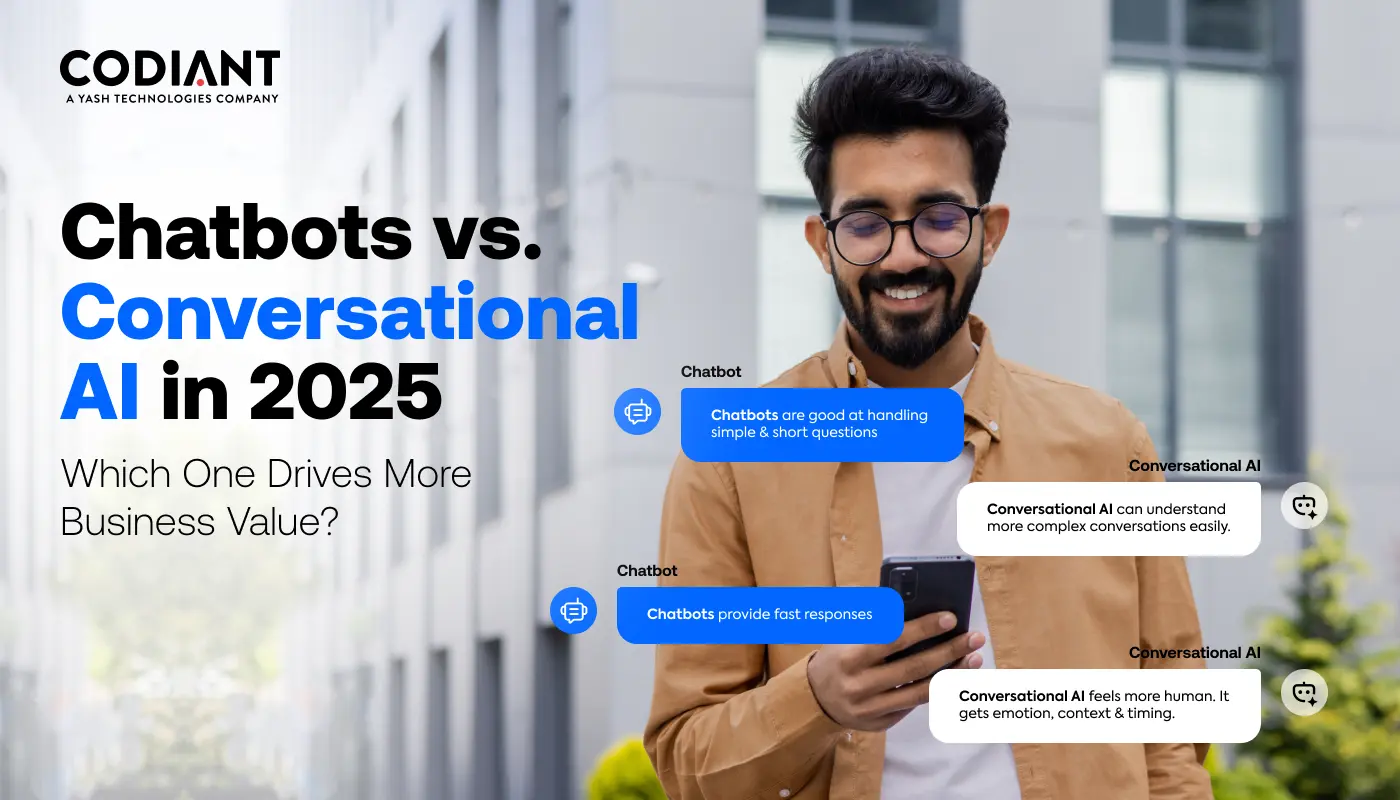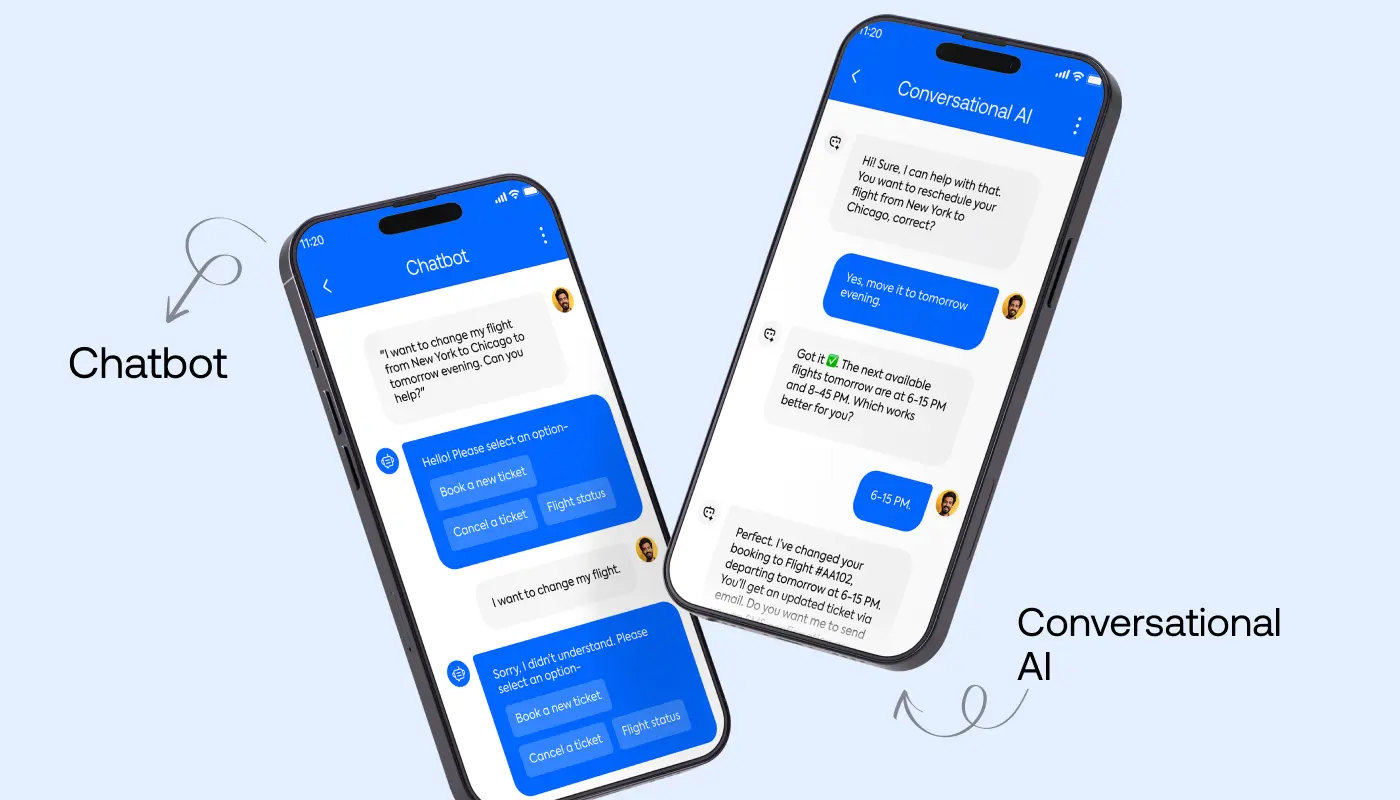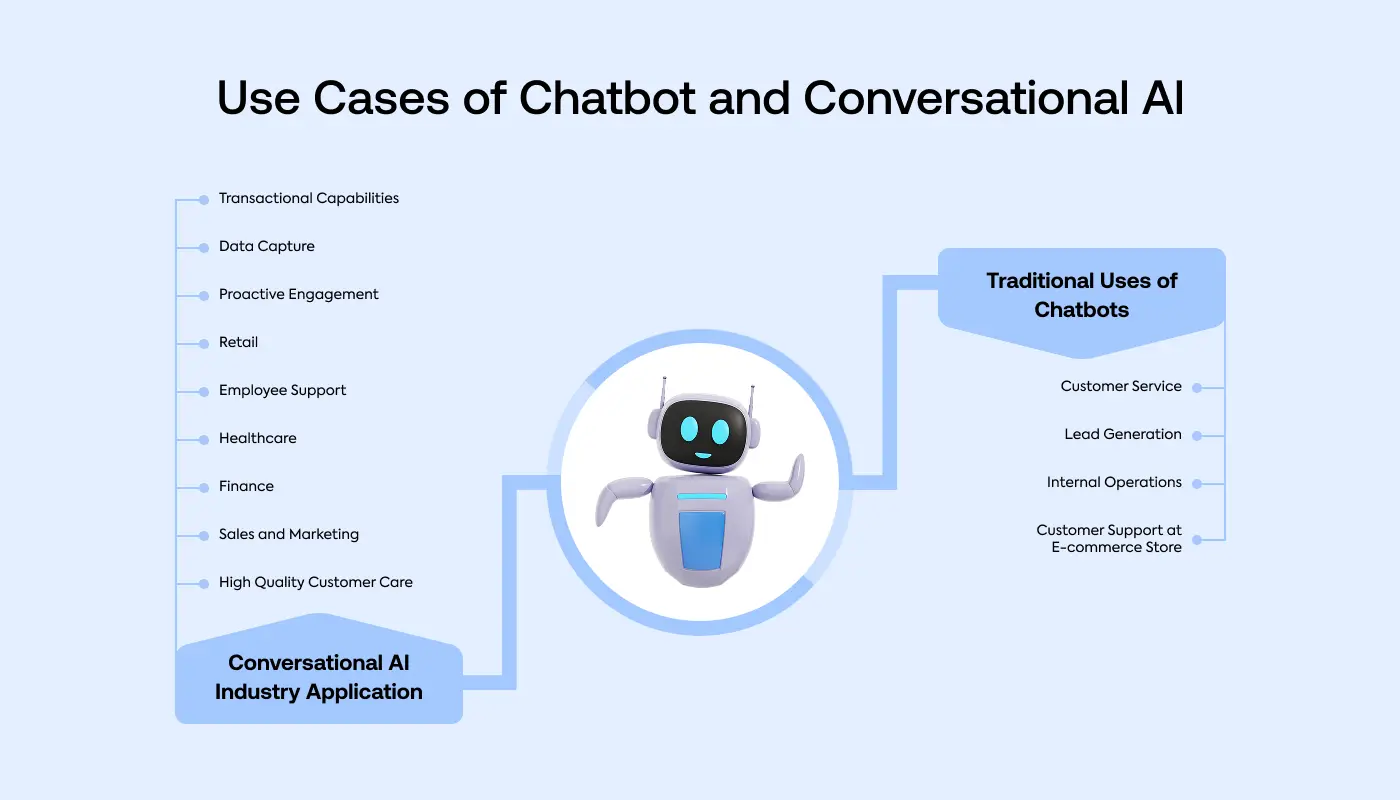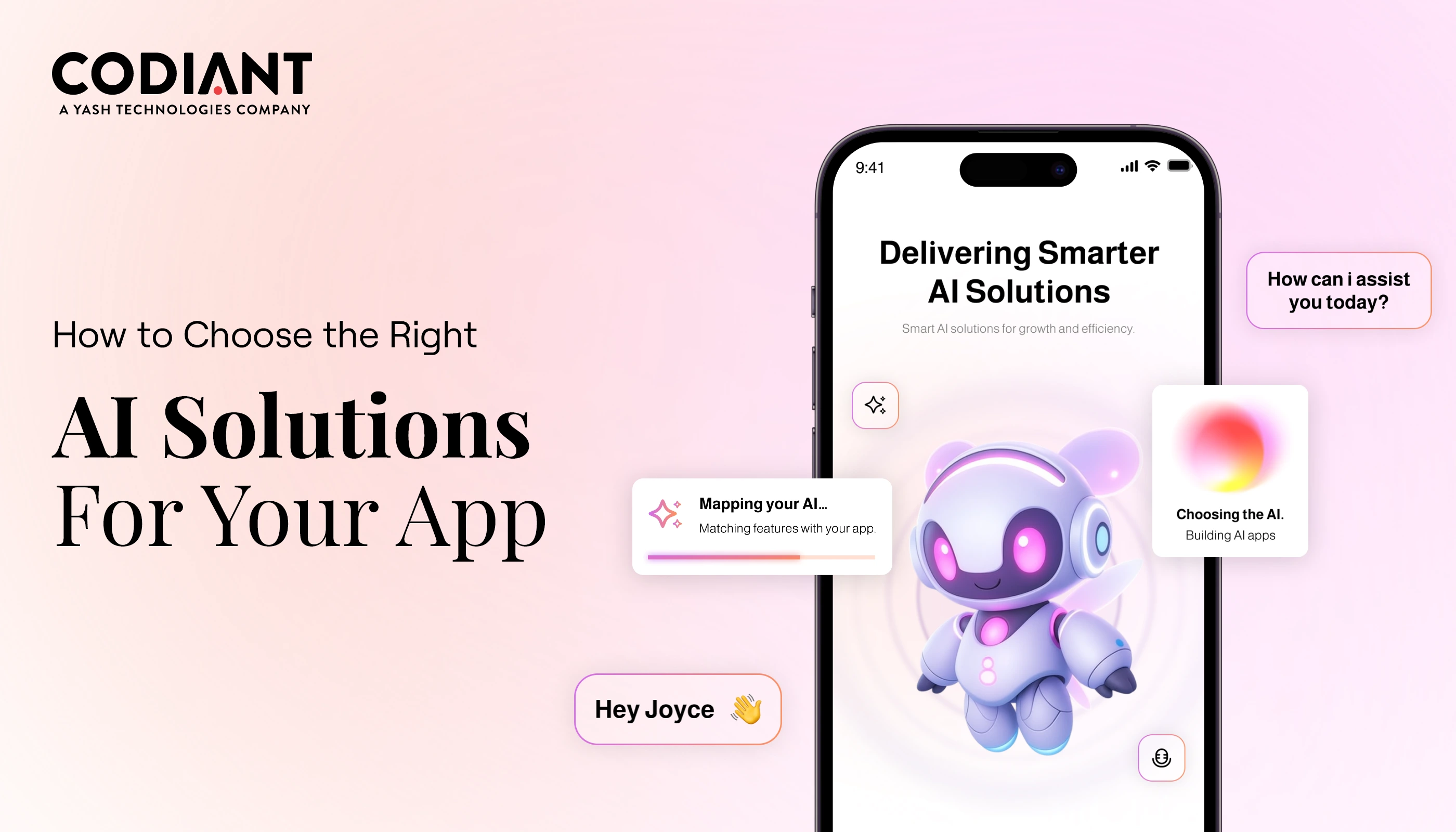Which is Better for Your Business in 2025- Chatbots or Conversational AI?
Table of Contents
Subscribe To Our Newsletter

In a Nutshell:
- Chatbots = Simple & Fast- Great for FAQs, appointment bookings & routine customer support.
- Conversational AI = Smart & Scalable- Uses NLP and machine learning to understand context, personalize replies & handle complex interactions.
- Key Difference- Chatbots follow rules; Conversational AI learns, adapts & delivers human-like conversations.
- Business Impact- Chatbots cut costs quickly; Conversational AI drives loyalty, conversions & long-term ROI.
- 2025 Reality- Most companies use a hybrid model – chatbots for speed, Conversational AI for personalization – to deliver AI-powered customer experiences.
In 2025 one of the most important questions businesses are asking is simple- Chatbots vs conversational AI – which delivers more value?
For years chatbots helped companies handle routine tasks like from answering FAQs to booking appointments. But as customer expectations shifted toward faster more human-like interactions the rise of intelligent virtual agents powered by natural language understanding changed the game.
Today, the real battle isn’t just about automating conversations. It’s all about creating an AI-powered customer experience that feels personal context-aware & scalable across industries.
From retail to healthcare to financial services organizations are rethinking how digital conversations impact satisfaction, loyalty & revenue.
This blog takes you beyond definitions & explores where each technology fits, what separates them & how to make the right choice for your business in 2025.
Chatbots vs Conversational AI – What’s the Difference and Which Is Better?
If you run a business in 2025, you’ve probably heard about chatbots vs conversational AI. At first, they sound the same. But they’re not.
AI Chatbot Development is the simpler one. Think of it like a FAQ machine. It gives short, fixed answers when customers ask common questions. For example- “What are your opening hours?” or “Where is my order?” A chatbot is fast & helpful but it cannot always handle complex requests.
Conversational AI on the other hand is much smarter. It utilizes NLP (natural language processing) & machine learning chatbots to understand how people really talk. It can remember past chats learn from them & reply in a more natural way. You can even use voice-enabled assistants that sound almost human.
Here’s the key difference in approach-
- Chatbots are rule-based (if you ask X, they answer Y).
- Conversational AI is AI-powered (it listens understands & responds in context).
So while chatbot AI is good for basic customer support, conversation AI is built for a true AI-powered customer experience.
The Choice Shapes Your ROI
Don’t just settle for answering questions – turn every customer interaction into a growth opportunity. Whether you start small with chatbots or scale big with conversational AI, the right choice can cut costs, boost loyalty & drive revenue in 2025.
Core Comparison Between Chatbots and Conversational AI

Now that you know the basics let us compare them head-to-head. This is where the chatbots vs conversational AI debate gets real.
1. Complexity of Interactions
Chatbots
Chatbots are good at handling simple & short questions like “What’s your office timing?” or “Where is my order?” They follow a fixed script-if you ask something they don’t identify, they usually get confused or repeat the same answer. It’s seems like you are talking to an answering machine that cannot read your mind.
Conversational AI
Conversational AI can understand more complex conversations easily. It listens, remembers & responds in a natural way. If you ask it “Can you check my last order and suggest something similar?” it knows exactly what to do. It can also adjust its tone based on your emotions-friendly, formal or supportive-just like a real assistant.
In short- Chatbots reply, Conversational AI converses.
2. User Experience Journey
Chatbots
Chatbots provide fast responses, which can be a good thing when customers are impatient. But sometimes they can come off as robotic or chilly. For example, if you write, “I am angry I haven’t got my refund yet” a chatbot might simply respond, “Please get in touch with support.”
Conversational AI
Conversational AI feels more human. It gets emotion, context & timing. If someone says, “I’m frustrated with my refund” AI could respond, “I am sorry you experienced that problem. “I’ll just go ahead and check the status of your refund today.” And yet that simple little distinction lets customers know they’re heard and valued. Another is that businesses that incorporate Conversational AI tend to have better customer satisfaction, as the interaction seems more like speaking with a human and not a machine.
3. Scalability & Adaptability
Chatbots
Chatbots are good for small tasks and good for startups also who just need basic help-like answering FAQs or booking simple appointments. But as the business grows, chatbots find it hard to handle more requests or complex customer issues. They need a lot of manual updates to stay useful.
Conversational AI
Conversational AI is built to grow with the business. It learns from every chat, which improves its answers automatically. It can manage lots of chats at once, switch between different languages & work across channels like email, WhatsApp & websites. It’s like having a support team that keeps learning and expanding with you.
Think of it this way- Chatbots walk. Conversational AI runs and evolves.
4. Integration with Enterprise Systems
Chatbots
Most chatbots can only connect to simple tools-like a website’s FAQ section or a basic app. They can’t access real-time business data or pull information from multiple systems. For example, if you ask a chatbot, “Can you check my delivery address in your system?”, it might not have access to that database.
Conversational AI
Conversational AI easily connects with complex tools-like CRMs, ERPs, payment gateways, or customer service platforms. That means it can look up customer orders, track shipments, update account details, or even create reports. For example, a customer can say, “Update my phone number in my account,” and AI will do it instantly.
It’s not just smart-it’s connected. That’s why large enterprises prefer Conversational AI for complete automation and better workflows.
5. Cost & Long-Term ROI (Return on Investment)
Chatbots
Chatbots cost less at the beginning. They’re quick to set up and perfect for small businesses that need simple automation. But with time, they may need more manual updates or human support to fix gaps, which adds extra cost. So while they may be cheap upfront but, they might not save as much money in the long run.
Conversational AI
Conversational AI costs more to build at first, but it’s an investment that pays off. It improves automatically, reduces manual work & increases sales by engaging customers better. Businesses using AI see more leads, faster support & higher customer loyalty. Over time, the system’s smart learning ability saves time and money-delivering a better ROI.
Quick fix vs. long-term growth- Chatbots are short-term helpers; Conversational AI is a growth partner.
In Summary
If we put it simply-
| Aspect | Chatbots | Conversational AI |
| Complexity | Handles basic Q&A | Understands complex, multi-step chats |
| Experience | Feels robotic | Feels natural and human-like |
| Scalability | Limited to small tasks | Grows with your business |
| Integration | Connects to few systems | Works across full enterprise tools |
| Cost & ROI | Cheaper at first | Higher ROI over time |
So, Chatbot AI = Simple, Fast & Cheap.
Conversational AI = Smart, Scalable & Built for the Future.
What Are Chatbots Used for in Modern Businesses?
The journey of the AI chatbot in business has been very interesting. At first, chatbots were simple programs. They could only follow rules & give short answers. For example, if you typed “What are your hours?” they would give one fixed reply. They worked like a menu, not like a real conversation.
Over time, businesses saw that chatbots could do much more. With better technology, they became smarter & faster. Now, chatbots are not only answering questions but also helping companies grow & connect better with their customers.
Past- How Businesses Used Chatbots
In the early years, chatbots were limited but useful-
- They gave quick replies to basic eCommerce support questions like “Where is my order?”
- They helped in small tasks such as showing store hours, giving links, or booking a meeting.
- They reduced some pressure on human staff by answering the most common questions.
These bots were simple, but they saved time & money. They also opened the door for businesses to try customer support automation for the first time.
Present- Smarter and More Powerful
Today, modern chatbots work as automated customer support solutions. This means they are no longer just tools-they are part of the business strategy. Companies now use chatbots to-
- Handle thousands of chats at the same time, without making customers wait.
- Give omnichannel customer engagement, so customers get the same support on websites, apps, or social media.
- Connect with real systems to share updates about orders, payments, or accounts.
- Collect data from conversations to understand what customers want.
- Pass the chat to a live agent when a problem becomes complex.
Also Read: AI Chatbots and Their Role in Enhanced Customer Experiences
How Chatbots Have Evolved – Key Statistics and Trends in 2025
- Studies show that companies that are using AI chatbots actually save up to 30% cost on customer support.
- In lot of industries, chatbots now handle 70% of customer questions without a human.
- Customers love quick replies-over 60% of users prefer to chat with businesses that answer instantly through a chatbot.
The Business Edge You Gain
Chatbots started as simple tools that could only answer basic questions. But now, they’ve grown into smart digital assistants that can understand people, help them faster and even solve problems on their own.
By using automated customer support, companies not only saving money & time but they are also giving their customers better fast and more personal service.
Chatbots for today’s businesses helps in building customer trust, increase loyalty and keep conversations smooth across websites, apps and social platforms.
In short, smart chatbots don’t just answer questions-they help businesses grow.

How Is Conversational AI Used in Business?
While chatbots were once limited, conversation AI has opened a new world for businesses. Instead of only giving fixed answers, this technology understands language, remembers context & learns from each talk. It feels more natural, almost like chatting with a real person.
This makes conversation AI much more powerful. It doesn’t just answer questions-it builds relationships, improves sales & creates smooth customer journeys. Businesses are now using it as part of their conversational marketing strategy to connect with people in a personal & meaningful way.
Real Use Cases of Conversation AI
- Boosting Customer Engagement with Personalization
Customers don’t like generic replies. Intelligent virtual agents powered by AI can study behavior & suggest the right product, service, or answer. For example, an online store can recommend clothes based on a customer’s past purchases. - Virtual Healthcare Assistants
In healthcare, voice-enabled assistants & smart chat tools help patients book appointments, answer medical FAQs, or remind them to take medicines. This saves time for doctors & gives patients faster support. - Converting Conversations Into Conversions
Instead of a cold sales pitch, conversation AI warms up leads by asking the right questions & guiding them step by step. This creates trust & helps businesses close more deals. - Automating Operations for Smarter Enterprises
Large companies use conversation AI to handle HR queries, IT support & even staff training. This reduces the workload for employees & speeds up daily tasks. - Scalable Customer Support
Unlike humans, AI never gets tired. With AI-powered customer experience, businesses can serve thousands of people at once, across different time zones & languages.
The Impact on Business in 2025
- Gartner predicts that by 2025 nearly 70% of customer interactions will be handled by AI technologies which will also include intelligent virtual agents & automation tools.
- Companies will report up to 25% higher conversion rates because of using conversation AI as part of their conversational marketing strategy.
- Customers expect instant answers & voice-enabled assistants are becoming a natural way to interact.
The Big Advantage
The future of business is not about answering questions, but about creating smart, human-like conversations. With conversation AI, companies can provide a more personal touch, improve trust & deliver faster service. It’s not just customer service anymore-it’s a complete AI-powered customer experience that helps businesses grow & stay ahead.
Business Applications of Chatbots and Conversational AI
Today, almost every business talk to customers using some kind of smart chat system. But not all of them work the same way.
Some use chatbots which follow fixed rules and reply to pre-written questions. They are quick, helpful & handle simple tasks easily. Other businesses use Conversational AI which can actually understand what people say, remember past chats & reply like a human.
Both in the end helps businesses in saving time and money & stay available 24/7-but Conversational AI takes things one step further by adding real understanding and human-like interaction. Let us look at how both AI’s are helping different industries in 2025.
Retail & E-Commerce
Online shopping system has changed a lot in the last years. Chatbots help customers in the retail sector to track their orders, find return policies or check if a product is there in stocks or not. They can also send delivery updates or discount codes. These bots work fast, never get tired & make sure buyers get instant replies. But when questions get tricky—like “Can you show me dresses like the one I bought last year?”—chatbots often get stuck.
That’s where Conversational AI becomes helpful. It doesn’t just answer-it understands. It looks at past purchases, recommends similar items & even remembers size, color, or style preferences. Some AI systems chat naturally making the conversation more humanly like- “You bought blue sneakers last summer. We have a new design in the same color-would you like to see it?”
In 2025, big brands are using Conversational AI to make shopping more personal. It feels less like talking to a robot and more like chatting with a store assistant who knows you and your preferences. This leads to more happy customers, fewer returns & more sales.
Healthcare
In hospitals and clinics, chatbots help patients a lot, they schedule appointments, send reminders share test results & answer basic health questions like “What are the symptoms of the flu?” or “What’s the hospital timing?” They act as a big helping hand for busy doctors & nurses.
But when a patient says, “I’ve had a fever for three days and chest pain when I breathe,” a chatbot cannot decide what’s serious or what’s not.
But in this case Conversational AI becomes really helpful. It listens carefully, checks symptoms & understands urgency. It can ask follow-up questions like, “Do you also have trouble breathing?” and guide the patient safely-either by scheduling a doctor visit or sending them to emergency care.
It also supports many languages, helping patients who don’t speak English fluently. In 2025, many hospitals use AI assistants that connect to medical records, track medicine reminders & offer follow-up advice. These systems make healthcare faster, safer & more personal-like having a smart nurse available anytime.
Banking & Insurance
Chatbots in banks help customers check balances, reset passwords, or get loan information quickly. They’re good at routine tasks and reduce waiting time at call centers. For insurance, they remind customers about renewals or claim document submissions.
But financial questions can be complex-and that’s where Conversational AI steps in. It can explain policies, calculate loan eligibility & even guide customers through claim processes step-by-step. For example, when a person says, “I need car insurance for my new SUV,” AI can show plans, compare costs, explain what’s covered & even complete the purchase.
AI also recognizes emotions-if a customer sounds upset about a delay, it can respond politely and escalate to a human agent. In 2025, many banks use AI that understands tone and intent, giving customers advice that fits their situation. These AI systems have helped companies reduce fraud, build stronger trust & handle thousands of conversations at once-all without losing the human touch.
Travel & Hospitality
Traveling has become smoother thanks to chatbots and AI. Chatbots handle simple things-booking tickets, confirming reservations, sending flight updates, or helping travelers check in. They’re quick and reliable for short questions.
However, Conversational AI takes travel planning to a new level. It understands needs like “Find me a beach resort under $2000 with breakfast and Wi-Fi.” It searches across booking sites, checks ratings & gives customized options. AI can even remember traveler preferences, such as window seats, favorite destinations, or dietary needs.
It can chat in different languages, making it easier for global travelers. Imagine landing in Paris and getting a message- “Welcome back! Would you like to visit your favorite café again?” That’s Conversational AI-friendly, personal & proactive.
Hotels and airlines now use it to offer real-time help, upsell room upgrades & handle complaints before they become problems. This smart assistance means fewer calls, smoother trips & happier travelers.
Education & EdTech
In schools and learning apps, chatbots are like digital receptionists. They answer questions about admission dates, fees, or course details. They help teachers by collecting forms or connecting students to the right department. But they can’t understand emotions or learning styles.
Conversational AI changes that. It works like a virtual teacher who listens, guides & motivates. If a student struggles, AI can adjust the difficulty level, give simpler examples, or switch to a video explanation. It can even detect frustration and say, “Looks like this topic is tricky-shall we try an easier one first?”
AI tutors also track progress, remind students about homework & support multiple languages and integrate AI detector to help maintain academic integrity.. For parents, AI systems share reports, attendance & feedback instantly. In 2025, EdTech platforms use these smart assistants to make learning more personal and less stressful. Students feel supported & teachers can focus more on creativity than admin work.
ROI and Cost-Benefit Analysis- Chatbots vs Conversational AI
When choosing between chatbots and conversational AI, one big question always comes up – Which gives better results for the money you spend? That’s where ROI (Return on Investment) comes in. ROI helps you see how much value or savings you get compared to what you pay for the system.
In 2025, both chatbots and conversational AI can save businesses time and money, but in different ways. Chatbots are quick to build, cheaper to run & great for simple customer questions. Conversational AI costs more at first, but it gives better long-term results through smarter automation and improved customer satisfaction.
Here’s a simple comparison-
| Feature | Chatbots | Conversational AI |
| Setup Cost | Lower – good for small businesses or start-ups | Higher – fits growing and large companies |
| Maintenance | Easy and less expensive | Needs regular updates and training |
| Capabilities | Answers basic questions only | Handles complex chats, emotions & context |
| Customer Experience | Fast but robotic | Natural, personalized & human-like |
| ROI Timeline | 3 to 6 months | 6 to 12 months, but long-term payoff is higher |
| Scalability | Limited growth potential | Adapts as your business grows |
For example, a small eCommerce store might save money using a simple chatbot to manage FAQs or order updates. But a large bank or hospital can gain much more with conversational AI that understands voice, handles private data & speaks multiple languages.
In short, chatbots give quick savings, but conversational AI builds lasting value. If your business wants fast results on a small budget, start with chatbots. If you aim for stronger customer relationships and future growth, conversational AI gives a higher ROI over time.
No matter your choice, investing in automation today helps your business stay competitive, save costs & offer better service in the long run.
Chatbot Development Cost vs Conversational AI Cost in 2025
When comparing chatbots vs conversational AI, cost is often the first question businesses ask. Chatbots are economical to build since they depend on pre-set rules & scripts. They are perfect for FAQs booking requests & simple support tasks.
Conversational AI on the other hand, requires a bigger budget because it uses NLP, machine learning & enterprise-level integrations. While the setup cost is higher it delivers smarter automation, richer personalization & greater scalability, making it a future-ready automated customer support solution.
Here’s a cost-focused comparison:
| Factor | Chatbots | Conversational AI |
| Initial Cost | $5,000 – $20,000 (basic setup, rules-based scripts) | $30,000 – $100,000+ (AI model training, NLP, integrations) |
| Maintenance | $500 – $2,000/month (script updates, bug fixes) | $3,000 – $10,000/month (retraining, cloud costs, upgrades) |
| Speed of Deployment | Fast (1–4 weeks) | Slower (2–6 months) |
| Scalability | Limited (basic queries, single channel) | High (multi-channel, multi-language, complex workflows) |
| ROI of Chatbots vs Conversational AI | Quick cost savings, short-term ROI | Higher long-term ROI through enterprise AI adoption |
| Best Fit For | Small businesses, startups, FAQs | Enterprises, global brands, complex workflows |
Top Business Benefits of Conversational AI in 2025
In 2025, conversational AI has moved beyond being a customer support tool – it’s now a growth engine for businesses of every size. By combining natural language understanding, context awareness & machine learning, it delivers experiences that are faster, smarter & more human. Here’s how it’s reshaping business performance across industries-
1. Significant Cost Reduction
Conversational AI automates repetitive queries and high-volume support requests, cutting the need for large customer service teams. According to reports, companies save up to 30 to 40% on support costs by automating first-level interactions. These savings can then be reinvested in product innovation or customer engagement initiatives – helping brands scale without increasing operational overhead.
2. 24/7 Availability and Faster Response
Unlike human agents, conversational AI doesn’t sleep. It provides round-the-clock support, instantly resolving customer questions – from order tracking to billing updates – across multiple channels. This always-on availability not only boosts response time but also builds trust and convenience for global customers in different time zones.
3. Smarter Data Insights
Every interaction handled by conversational AI generates valuable insights. By analyzing chat logs, sentiment patterns & customer behavior, businesses can identify service gaps, forecast demand & design better user journeys. These insights transform support operations into a real-time intelligence hub that guides decision-making.
4. Increased Conversion and Retention
Conversational AI doesn’t just answer questions – it guides users toward conversions. By recommending the right product or offer at the right time, it improves engagement and increases conversion rates. Moreover, personalized interactions lead to stronger relationships and higher customer retention, turning first-time buyers into loyal advocates.
5. Brand Differentiation Through Personalization
In crowded markets, personalization is the new currency of loyalty. Conversational AI enables one-to-one experiences by understanding customer intent, tone & past behavior. From personalized recommendations to proactive outreach, brands can stand out by delivering AI-powered conversations that feel genuinely human.
Voice AI or Text Chatbots – Which Is Better?
As technology improves, many businesses are asking an important question – will voice or text lead the future of AI conversations?
In 2025, there is no single answer. Both voice AI and text-based chatbots help businesses talk to customers in different ways. Each one has its own strengths depending on how and where it’s used.
The Growth of Voice AI
Voice AI is becoming popular because of smart speakers, virtual assistants & hands-free devices. Many industries like healthcare, automotive & retail now use it. For example, a person can say, “Check my balance” or “Book an appointment,” and get an instant spoken reply. That’s what AI voice assistants for business can do.
Voice AI feels more natural and human. It helps in situations where people need quick answers without typing. Experts say that by 2025, over 60% of customer service tasks will include some form of voice automation.
Why Text Chatbots Still Matter
Even though voice AI is growing fast, text chatbots are still widely used on websites, apps & social media. They are easy to use, protect privacy & connect well with CRM or helpdesk systems. For online stores, banks & software companies, text chatbots are the easiest and most affordable way to handle customer messages.
The Future- Using Both Together
In 2025, businesses won’t have to choose between voice or text. The future belongs to multimodal conversational AI – systems that let users switch between voice and text whenever they want. For example, a person can start a chat by talking on a smart speaker and then continue typing on their phone.
In simple terms-
- Voice AI adds speed and a human touch.
- Text AI adds clarity and control.
Companies that use both together will give customers the best and most flexible experience.
Generative AI’s Role in Conversational Systems
In 2025, Generative AI is changing how businesses talk to customers. Unlike old chatbots that give fixed replies, new models like GPT-4, Claude & Gemini can read, understand & respond like real people. They learn from huge amounts of text and can understand feelings, tone & meaning-making conversations sound more natural.
The main power behind this change is the Large Language Model (LLM). These models don’t just look for keywords. They create replies on their own, based on what the user says and how they say it. This helps companies build assistants that can think, understand & adjust instead of giving the same answers every time.
How Generative AI Improves Conversations-
- Remembers Context – Generative AI can remember what users said before and use it later. For example, a bank bot can recall your last loan question and pick up where you left off.
- Writes Naturally – It gives answers that sound real, not robotic. It can show humor, care, or professionalism to match your tone.
- Personal Touch – By using data from CRMs and behavior, it customizes replies for every person, making each chat feel personal.
- Keeps Learning – Unlike basic bots, it keeps improving with every chat, making answers more helpful and accurate over time.
In short, Generative AI turns chatbots into true digital helpers-smart, friendly & able to hold real conversations. That’s why more companies are now using LLM-powered conversational AI to create better, faster & more human-like customer experiences.
The Role of Knowledge Bases and RAG in Conversational AI
In 2025, one of the biggest improvements in conversational AI comes from something called RAG, which stands for Retrieval-Augmented Generation. Don’t worry – it’s simpler than it sounds.
Think of RAG as your chatbot’s smart memory. Most chatbots can only reply based on what they were trained on. If you ask them something new, they might guess or give wrong answers. That’s where RAG helps. It connects your AI chatbot to a knowledge base – a library of real company data, documents & FAQs – so it can “look up” the right answer before replying.
Here’s how it works-
- Retrieval- The AI searches your company’s database for the most relevant information.
- Generation- It uses that info to write a clear, accurate answer in real time.
With RAG, your chatbot doesn’t just talk – it thinks with facts. It can pull data from manuals, support guides, or policies and respond just like a trained human expert. This makes replies more trustworthy, detailed & up to date.
For example, in a bank, a RAG-powered chatbot can instantly explain loan rules or account terms using official documents. In healthcare, it can answer patient questions using verified medical FAQs.
In short, RAG turns conversational AI into a knowledge-driven assistant – one that reduces errors, avoids guesswork & delivers answers your customers can truly rely on.
How to Choose the Right AI Chat Solution for Your Business in 2025
If you’re stuck between chatbot AI & conversation AI, here’s the truth – your choice depends on what your business actually needs right now.
A chatbot AI is perfect if you want something affordable, fast to deploy, & reliable for handling routine tasks. Think FAQs, appointment bookings, or order status updates. It gives you consistency & lowers support costs without requiring complex setup.
But if your business thrives on customer relationships & deeper engagement, conversation AI is the smarter bet. It uses natural language understanding to personalize interactions, making customers feel heard. This is where it ties directly into your conversational marketing strategy-helping you nurture leads, improve loyalty, & increase conversions.
Here’s where many businesses in 2025 are landing- they don’t pick one over the other. They invest in hybrid AI solutions-using chatbots for speed & conversation AI for personalization. Combined, they unlock a balanced approach to business automation software- reducing costs while creating experiences that feel less like tech, & more like trust.
Bottom line – Choose chatbot AI if you need quick wins & cost savings. Choose conversation AI if you want richer customer relationships. & if you want the best of both worlds? Go hybrid.
What Are the Biggest Challenges of Implementing Chatbots and Conversational AI?
While both Chatbots and Conversational AI make customer support faster and smarter, they also come with their own set of problems. Understanding these challenges helps businesses make better decisions before they start using them.
Challenges with Chatbots
Chatbots are easy to build and use, but they can also be frustrating for customers. They follow a fixed script – if someone asks a question that doesn’t match their list of answers, they often get stuck or reply with “I didn’t understand that.”
This makes the conversation feel robotic and less human.
For example, if a customer says, “My internet bill is wrong,” the chatbot might just repeat the payment link instead of trying to understand the issue. This can make users lose trust or feel unheard.
Chatbots also can’t read emotions or tone, so they treat every message the same-whether the user is calm or upset. And while they are great for basic questions, they can’t handle complex or changing needs without being reprogrammed.
So, even though chatbots save time and money, they can make customer service feel cold or limited if not designed carefully.
Challenges with Conversational AI
Conversational AI sounds smarter and more human, but it’s not perfect either. The biggest challenge is cost and setup. It needs lots of data, training & fine-tuning to understand how people talk. For small businesses, this can be expensive at first.
Another issue is data privacy. AI systems often store and learn from real customer messages, so they must follow strict rules like GDPR in Europe or HIPAA in healthcare. If not handled safely, there’s a risk of personal data leaks or misuse.
Conversational AI also depends on good-quality data. If it’s trained on wrong or biased information, it can make poor decisions or give confusing answers. Maintaining and updating it regularly takes skilled teams and ongoing effort.
Conclusion- Chatbots vs Conversational AI in 2025
If you’ve made it this far, you probably already see it- the debate of chatbots vs conversational AI isn’t really about which one “wins.” It’s about which one fits your business stage, goals, & customers.
Traditional chatbots still hold their ground for automated customer support solutions-they’re fast, cost-effective, & perfect for FAQs, bookings & lead qualification.
But as businesses compete on experience not just price conversational AI becomes the real differentiator. With natural language processing & contextual learning, it creates an AI-powered customer experience that feels human scales with demand & strengthens brand loyalty.
Here’s the takeaway-
- Start simple with chatbots if you’re chasing quick automation.
- Invest in conversational AI if you want personalization, scalability & future-proof growth.
- Or better yet, blend both for a smart balance of efficiency & engagement.
The future of customer experience lies in intelligent support systems that work seamlessly across every channel, deliver instant and accurate responses, and continually improve through real user interactions. With the rise of automation and smarter workflows, businesses can now enhance efficiency, reduce response times, and offer more personalized support than ever before. Many brands start by exploring free AI consulting services to identify the right solutions, streamline operations, and build a support ecosystem that’s ready for tomorrow.
Still debating chatbots vs conversational AI?
Let’s help you design a roadmap that fits your industry, budget & growth goals.
Frequently Asked Questions
No it’s not like that, actually chatbots are still valuable for businesses that just need automated customer support solutions like FAQs appointment booking or lead capture. Conversational AI is more advanced but also more resource-intensive – so the choice depends on your goals not trends.
On an average a basic chatbot can cost between $5000 to $20,000, but a full conversational AI solution cost ranges from $25,000 to $100,000+ it also depends on the features like NLP integrations & multi-channel support. The right fit depends on complexity & ROI expectations.
Industries like healthcare, banking & travel gain the most from conversational AI because they need personalized, contextual & often multilingual support. In contrast, industries like eCommerce or logistics often find traditional chatbots enough for order tracking, returns & quick answers.
Thanks to cloud platforms & SaaS providers small businesses can now access conversational AI at a fraction of enterprise costs. Many providers even offer tiered pricing or pay-as-you-go models making it realistic for start-ups & SMEs to adopt.
A chatbot usually shows ROI within 3 to 6 months by reducing support tickets & labor costs. Conversational AI takes longer – 6 to 12 months but drives bigger wins in customer retention upselling & AI-powered customer experience.
Featured Blogs
Read our thoughts and insights on the latest tech and business trends
How to Choose the Right AI Solutions for Your Existing App
- December 1, 2025
- Artificial Intelligence
Businesses today are under pressure to move faster, deliver personalized experiences, and operate with greater accuracy. This is why many enterprises and startups are now looking for ways to add AI features to their mobile... Read more
How to Enable AI for Smart Diet Planning and Client Progress Tracking
- November 26, 2025
- Artificial Intelligence
Smart diet planning and consistent progress tracking have become essential in a world where people want faster, more accurate ways to manage their health. Traditional methods like manual calorie counting or generic meal charts often... Read more
How to Digitize Your Home-Service Business with an AI-Powered Platform
- November 21, 2025
- Home Services
The home-service industry - covering HVAC, plumbing, electrical, and cleaning—has long relied on manual scheduling, phone-based bookings, and paper invoices. But as customer expectations shift toward instant communication and transparency, these traditional processes are no... Read more





